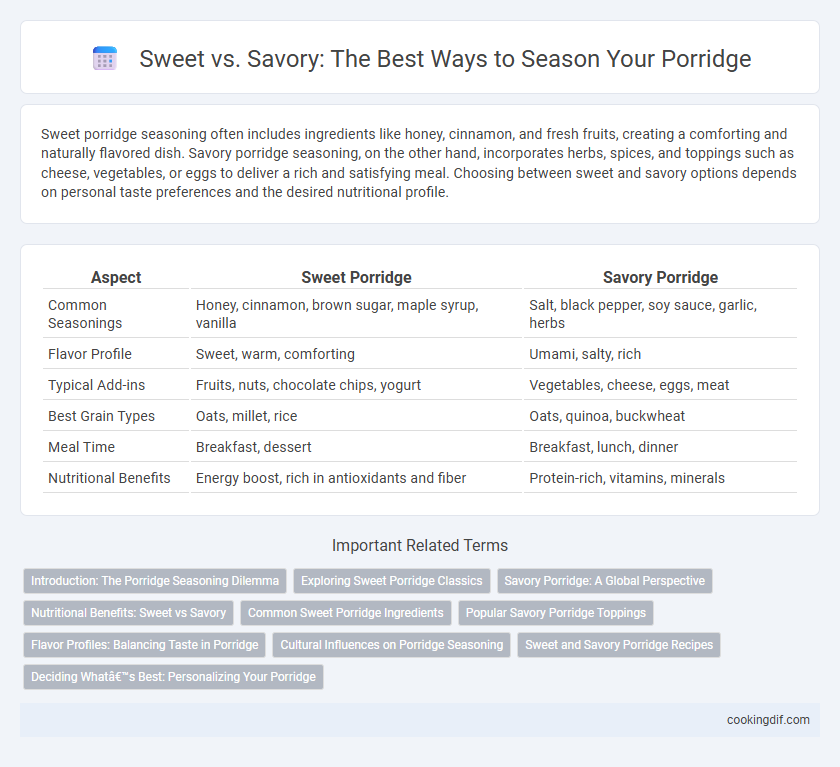Sweet porridge seasoning often includes ingredients like honey, cinnamon, and fresh fruits, creating a comforting and naturally flavored dish. Savory porridge seasoning, on the other hand, incorporates herbs, spices, and toppings such as cheese, vegetables, or eggs to deliver a rich and satisfying meal. Choosing between sweet and savory options depends on personal taste preferences and the desired nutritional profile.
Table of Comparison
| Aspect | Sweet Porridge | Savory Porridge |
|---|---|---|
| Common Seasonings | Honey, cinnamon, brown sugar, maple syrup, vanilla | Salt, black pepper, soy sauce, garlic, herbs |
| Flavor Profile | Sweet, warm, comforting | Umami, salty, rich |
| Typical Add-ins | Fruits, nuts, chocolate chips, yogurt | Vegetables, cheese, eggs, meat |
| Best Grain Types | Oats, millet, rice | Oats, quinoa, buckwheat |
| Meal Time | Breakfast, dessert | Breakfast, lunch, dinner |
| Nutritional Benefits | Energy boost, rich in antioxidants and fiber | Protein-rich, vitamins, minerals |
Introduction: The Porridge Seasoning Dilemma
Choosing between sweet and savory seasoning for porridge hinges on personal taste preferences and cultural influences. Sweet porridge often incorporates ingredients like cinnamon, honey, and fruits, enhancing its natural creaminess with sugary and aromatic notes. Savory porridge, seasoned with herbs, cheese, or spices, transforms the dish into a hearty, comforting meal suitable for any time of day.
Exploring Sweet Porridge Classics
Sweet porridge classics often feature cinnamon, nutmeg, and vanilla, enhancing the natural creaminess of oats or rice for a comforting breakfast. Fresh fruits like berries, bananas, and apples add vibrant flavors and antioxidant benefits, while sweeteners such as honey, maple syrup, or brown sugar provide balanced sweetness. Texture-rich toppings like nuts, seeds, and dried fruits contribute crunch and nutritional value, making sweet porridge both satisfying and wholesome.
Savory Porridge: A Global Perspective
Savory porridge varieties showcase diverse cultural flavors, such as Korean juk featuring mushrooms and soy sauce, Italian polenta topped with herbs and cheese, and West African millet porridge seasoned with spices and greens. These savory options highlight the nutritional benefits of incorporating vegetables, proteins, and spices, elevating porridge from a simple grain dish to a balanced, hearty meal. Global savory porridge recipes emphasize umami and spice profiles, catering to both traditional eating habits and modern culinary innovations.
Nutritional Benefits: Sweet vs Savory
Sweet porridge seasoning often incorporates ingredients like honey, fruit, and cinnamon, providing natural antioxidants, vitamins, and minerals while delivering quick energy through natural sugars. Savory porridge seasoning typically includes herbs, spices, and vegetables, offering higher protein, fiber, and essential micronutrients like iron and magnesium for sustained energy and digestive health. Choosing between sweet and savory porridge seasonings depends on individual nutritional goals, such as immediate energy top-up versus balanced nutrient intake for prolonged satiety.
Common Sweet Porridge Ingredients
Common sweet porridge ingredients include honey, cinnamon, fresh or dried fruits like berries and bananas, and nuts such as almonds or walnuts. These ingredients enhance the natural creaminess of oats while providing a balance of sweetness and texture. Incorporating spices like nutmeg or vanilla extract further elevates the flavor profile, creating a comforting and nutritious breakfast option.
Popular Savory Porridge Toppings
Popular savory porridge toppings include ingredients such as scallions, soy sauce, sesame oil, fried shallots, and preserved vegetables, which enhance umami flavors and create a rich, satisfying dish. Proteins like shredded chicken, minced pork, century egg, and salted duck egg are often added to boost nutritional value and texture. These savory seasonings balance the porridge's creamy base, offering a hearty alternative to sweet versions commonly topped with fruits or sugar.
Flavor Profiles: Balancing Taste in Porridge
Sweet porridge seasoning often includes ingredients like cinnamon, honey, and fresh fruit, creating a rich, warm flavor profile with natural sweetness and aromatic spices. Savory porridge typically features salt, herbs, cheese, or cooked vegetables, offering a hearty and umami-rich taste that enhances the grain's earthy base. Balancing these contrasting flavor profiles involves adjusting seasoning intensity to highlight porridge's texture while complementing either sweet or savory notes without overpowering the dish.
Cultural Influences on Porridge Seasoning
Porridge seasoning varies significantly across cultures, reflecting diverse culinary traditions and local ingredients. In Western cultures, sweet toppings like honey, cinnamon, and berries dominate, while savory versions with salt, cheese, or herbs are prevalent in Nordic and Asian cuisines. These cultural influences shape the flavor profiles, nutritional content, and even the occasions on which porridge is consumed.
Sweet and Savory Porridge Recipes
Sweet porridge recipes often feature ingredients like cinnamon, honey, fresh fruits, and nuts, creating a naturally rich and comforting flavor profile. Savory porridge options include toppings such as sauteed mushrooms, cheese, herbs, and eggs, offering a hearty and satisfying alternative. Balancing sweet and savory seasonings can elevate the porridge experience by incorporating diverse textures and complementary tastes.
Deciding What’s Best: Personalizing Your Porridge
Customizing porridge seasoning depends on individual taste preferences and nutritional goals, with sweet options like honey, cinnamon, or fruit providing natural energy and antioxidants. Savory choices such as cheese, herbs, or sauteed vegetables offer protein, vitamins, and a satisfying umami flavor. Balancing these ingredients allows for a personalized porridge experience tailored to dietary needs and flavor profiles.
Sweet vs Savory for porridge seasoning Infographic

 cookingdif.com
cookingdif.com